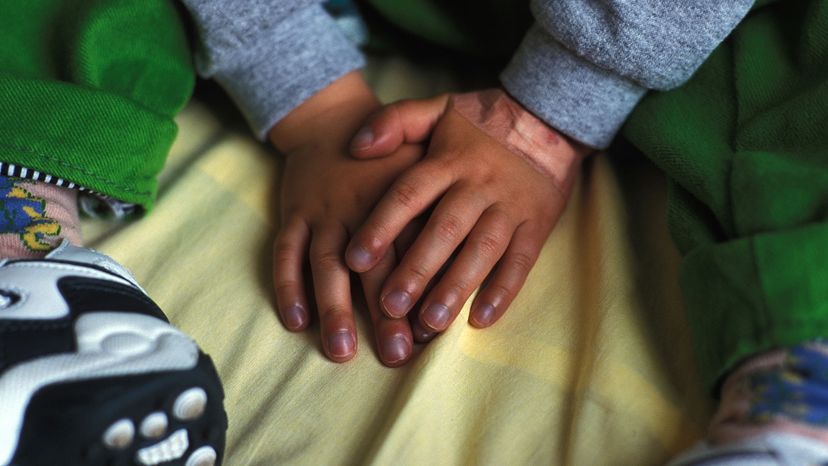 “This Moldavan child’s blue fingers are evidence of a cardiac malformation. BSIP/UIG Via Getty Images
“This Moldavan child’s blue fingers are evidence of a cardiac malformation. BSIP/UIG Via Getty Images
Fans of television medical dramas usually know what common terms like "code" or "BP" mean. But cyanotic? That one’s a little too clinical for laypeople. Once you know the meaning of the word, however, it’s easy enough to remember. You see, "cyan" is a specific shade of blue (check the old Crayola box if you want a refresher). "Osis" is the medical term for a specific state or diseased condition. So, cyanosis literally translates to "state of being blue."
While that’s fine for a Smurf and all, the rest of us don’t want to become cyanotic anytime soon. That’s because cyanosis usually is a sign of a serious underlying condition.
"The cause of cyanosis is always a decrease in the amount of oxygen-rich blood," explains Dr. Lisa Moreno-Walton, president of the American Academy of Emergency Medicine in an email. However, lots of issues can cause this decrease, none of them good.
There are two types of cyanosis, Moreno-Walton says. Peripheral cyanosis causes a blue tinge in the fingers, nail beds or even the limbs. Central cyanosis affects the tongue and mucous membranes. "All the things that cause central cyanosis will result in peripheral cyanosis, but all peripheral cyanosis is not the result of central cyanosis," she notes. (If you have darker skin you may notice cyanosis on your lips or nails rather than on your skin.)
There are a lot of things that can affect a person’s blood oxygen levels. In order to squash cyanosis, oxygen must first be given to the patient, and then the underlying cause has to be treated. Causes of cyanosis can include:
- Overall decrease in blood flow. This can occur when a cast, splint, Band-aid or even a bandage is applied too tightly, cutting off blood flow. Most of the time, this isn’t a big deal, but not always. "Even a constricting ace bandage that is not removed promptly can ultimately result in the loss of a limb," Moreno-Walton says.
- Exposure to the elements. "In extreme cold temperatures, the body will shunt blood to the brain and the core in order to preserve the functions of the brain, heart and kidneys, and so the feet and hands will become cold and blue," she explains.
- Imminent death. The same "shunting" also happens when a person is in the process of dying, often signaling to health care professionals that a hospice patient is nearing the end.
- Lack of environmental oxygen. "Mountain climbers also can develop cyanosis, since environmental oxygen is decreased at higher altitudes," she says. A fix is easy enough, fortunately. "For patients with mountain sickness, descent is the cure."
- Congenital heart condition. Newborns who are cyanotic have a malformation of the heart and/or great vessels. "These conditions require surgical correction," says Moreno-Walton. "It is rare for these conditions to be diagnosed after birth in countries where ultrasound is part of prenatal care and in areas where prenatal care is the norm."
- Blood vessel spasms. People with certain conditions, such as Raynaud’s syndrome, commonly experience vascular spasms as a result of cold temperatures. "The fingers or hands become blue from lack of blood flow and then bright red when blood flow returns," she explains.
- Emphysema or congestive heart failure. Both are hallmarked by the heart’s reduced ability to pump blood and the fact that they are pretty common in older patients. "Some patients with conditions such as these are always somewhat cyanotic, and actually live with a decreased oxygen level and a bluish tinge to the skin and nail beds," says Moreno-Walton. "When oxygen saturation in the blood slowly decreases over time, the body can make accommodations that allow the patient to continue to live and function, although not normally. The person’s ability to exercise, the distance they can walk, and their ability to speak long sentences without taking a breath will decrease as the condition worsens."
- Trauma. Loss of blood, whether external or internal, can cause cyanosis. This has to be corrected by either repairing the wound or surgery.
- Severe asthma or pneumonia. Medication can typically get these patients back on track.
- Blood clots. Doctors treat dangerous clots by dissolving them with drugs or using radiological techniques to pull them out.
- Fat clots that dislodge when a large bone is fractured.
- Foreign matter injected into a vein by an intravenous drug user.
- Other drug use. "When individuals use drugs not prescribed by doctors or use prescription drugs in a manner not consistent with medical instructions, they may breathe in a slow and shallow manner that can result in dangerous cyanosis and death," Moreno-Walton says, noting that heroin, barbiturates and oxycontin are common culprits. "Inappropriate drug use can sometimes be treated with an antidote, and when an antidote is not available, patients sometimes need to be placed on life support machines until the drug clears their circulation naturally."
Cyanosis runs the gamut of being no big deal as long as it’s handled, to a sign that something is very, very wrong. But while there are a lot of cyanosis-related variables, one thing is for sure: "All cyanosis should be evaluated by a physician to determine whether or not it is life- or limb-threatening and a course of treatment recommended," says Moreno-Walton.
Now That’s Interesting
You can actually tell if blood is fully oxygenated just by looking at it. When everything’s normal, blood is bright red. When oxygen levels are low, the blood turns dark purple, or even blue-red in color.

